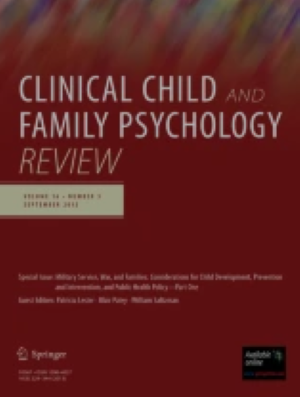Barriers and Facilitators to The Involvement of Under-Represented Children and Young People (aged 8-25) in Mental Health Research - a Systematic Review.
IF 6.1
1区 心理学
Q1 PSYCHOLOGY, CLINICAL
引用次数: 0
Abstract
Young people's involvement in mental health research enhances its relevance and impact. Involvement means conducting research with young people rather than just about them. However, under-representation persists among certain groups of young people, including ethnic minorities, those with disabilities, from lower-income households, with immigrant backgrounds and young people communicating in a language other than their first language. This systematic review applies the Behaviour Change Wheel (BCW) to explore barriers and facilitators to involving under-represented young people in mental health research and identify potential strategies for improvement. Five electronic databases and grey literature were systematically searched. Included studies focussed on children and young people (aged 8-25) from under-represented backgrounds involved in mental health research. The BCW was used to categorise barriers and facilitators as well as to map strategies to Intervention Functions. Five young people formed an oversight group, with three serving as co-researchers, contributing to search design, screening, data extraction and discussion. Twenty-seven studies from seven countries met the inclusion criteria. The majority of barriers and facilitators were linked to physical and social opportunity. Digital exclusion, time constraints, bureaucratic hurdles and mistrust of researchers were all barriers. Facilitators included flexible structures, inclusive communication and relationship building. Reported strategies to improve involvement aligned with enablement and environmental restructuring. Inclusive, adaptive research practices and improved reporting are needed to meaningfully engage under-represented young people in mental health research. Future research should prioritise perspectives of under-represented young people to better understand and address the barriers they face.代表性不足的儿童和青少年(8-25岁)参与心理健康研究的障碍和促进因素-系统综述。
青年人参与精神卫生研究可增强其相关性和影响。参与意味着与年轻人一起进行研究,而不仅仅是研究他们。然而,某些青年群体的代表性仍然不足,包括少数民族、残疾人、低收入家庭、移民背景和使用母语以外的语言进行交流的青年。本系统综述应用行为改变轮(BCW)来探索让代表性不足的年轻人参与心理健康研究的障碍和促进因素,并确定潜在的改进策略。系统检索了5个电子数据库和灰色文献。纳入的研究侧重于参与心理健康研究的背景不足的儿童和年轻人(8-25岁)。BCW用于对障碍和促进因素进行分类,并将策略映射到干预功能。五名年轻人组成了一个监督小组,其中三人作为共同研究人员,参与搜索设计、筛选、数据提取和讨论。来自7个国家的27项研究符合纳入标准。大多数障碍和促进因素与物质和社会机会有关。数字排斥、时间限制、官僚障碍和对研究人员的不信任都是障碍。促进因素包括灵活的结构、包容的沟通和关系的建立。报告的改善参与的策略与实施和环境重组相一致。要有意义地让代表性不足的年轻人参与精神卫生研究,需要包容性、适应性强的研究实践和改进报告。未来的研究应该优先考虑代表性不足的年轻人的观点,以更好地理解和解决他们面临的障碍。
本文章由计算机程序翻译,如有差异,请以英文原文为准。
求助全文
约1分钟内获得全文
求助全文
来源期刊

Clinical Child and Family Psychology Review
PSYCHOLOGY, CLINICAL-
CiteScore
10.50
自引率
4.30%
发文量
45
期刊介绍:
Editors-in-Chief: Dr. Ronald J. Prinz, University of South Carolina and Dr. Thomas H. Ollendick, Virginia Polytechnic Institute Clinical Child and Family Psychology Review is a quarterly, peer-reviewed journal that provides an international, interdisciplinary forum in which important and new developments in this field are identified and in-depth reviews on current thought and practices are published. The Journal publishes original research reviews, conceptual and theoretical papers, and related work in the broad area of the behavioral sciences that pertains to infants, children, adolescents, and families. Contributions originate from a wide array of disciplines including, but not limited to, psychology (e.g., clinical, community, developmental, family, school), medicine (e.g., family practice, pediatrics, psychiatry), public health, social work, and education. Topical content includes science and application and covers facets of etiology, assessment, description, treatment and intervention, prevention, methodology, and public policy. Submissions are by invitation only and undergo peer review. The Editors, in consultation with the Editorial Board, invite highly qualified experts to contribute original papers on topics of timely interest and significance.
 求助内容:
求助内容: 应助结果提醒方式:
应助结果提醒方式:


